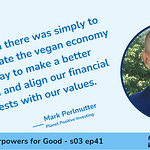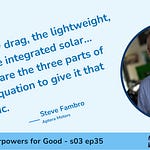Devin: What is your superpower?
Peter: My superpower is this: I did a seminar workshop 20 years ago. On my wall in my office, it says, “My mission in life is to leave a world that we’re proud of to our children.”
Author Peter Fiekowsky, an MIT-trained physicist, activist and Silicon Valley entrepreneur, has a plan to restore the climate to health by 2050—forget merely meeting the goals of the Paris Climate Agreement.
For context, he points out correctly that meeting the Paris targets is both challenging and only better than not meeting those thresholds. By achieving carbon neutrality in 2050, the world would no longer be contributing to global warming. Until then, however, the atmospheric carbon would continue to rise along with average global temperatures.
The only thing that makes that scenario acceptable is that not doing so could be much worse.
He argues that a path for complete climate restoration is open to us now. He puts forward the plan in his book Climate Restoration: The Only Future That Will Sustain the Human Race.
There are two shocking things about his plan. First, it can be implemented fully by the end of this decade. Second, we can do it cheaply; his budget is 1/1000 or three orders of magnitude smaller than conventional plans for meeting the Paris Agreement.
Those shocking facts make it easier to ignore him because his plan sounds too good to be true. Today, I’m suggesting only that we pause long enough to fully consider the possibility that we could do much better than merely achieve climate mediocrity over the next three decades.
In his book, Peter sets out the “Big Four” elements of his plan to offset carbon emissions well before 2050, allowing us to return atmospheric carbon to pre-industrial levels by that time.
While we spoke about each of the four actions in our conversation, which I hope you’ll watch or listen to, I’ll quote from his book here to capture the full benefit of written clarity.
The Big Four include:
Synthetic limestone manufacture. Nature has permanently stored 99 percent of Earth’s carbon in the form of limestone. The calcium carbonate made by shellfish and corals eventually sinks to the seafloor, where it becomes limestone. This has been happening for over a billion years. Recently engineers have learned to mimic the chemistry that oysters, mussels, and corals perfected long ago. Companies in the United Kingdom, the United States, and Australia have developed ways to use captured CO2 to produce synthetic limestone, high-quality rock that can substitute for the aggregate from quarries that is now used to make roadbeds and concrete.
Seaweed permaculture. Kelp and other seaweeds, called macro-algae, can grow as much as two or three feet a day, swiftly building their tissues from sunlight and CO2. Kelp forests once lined many of the Earth’s coastlines, pulling down more CO2, acre for acre, than the rainforests of the Amazon, while also providing shelter for fish and other sea creatures. When the seaweed dies in the course of its natural life cycle, it tends to sink. In the right circumstances, it takes the carbon it contains to the ocean depths, sequestering it far from the atmosphere for hundreds or thousands of years.
Ocean iron fertilization (OIF), also called ocean pasture restoration (OPR). OIF mimics in a controlled fashion the process that cooled the Earth 10 times in the last million years during the lead-up to ice ages. This powerful approach utilizes nature’s fastest large-scale carbon removal pathway and can be scaled up rapidly, with important benefits to ocean and fishery health while “farming” only about two percent of the ocean’s area.
Acceleration of natural methane oxidation. With the ability to remove CO2 by increasing two kinds of ocean photosynthesis as well as by manufacturing rock, we’re all set to restore the climate, right? Not quite. There’s one more challenge to solve, which has to do with the melting Arctic. Methane is the main component in the natural gas you may use for cooking or heating. It was produced in the ancient vegetation that turned into coal and oil, and it’s produced today when vegetation decays in wetlands. Methane has a short half-life in the atmosphere about eight years, compared to a millennium for CO2. But a ton of methane causes about 120 times more warming than a ton of CO2.
I’m going to resist the temptation to attempt to further explain his Big Four. It suffices to say that he’s thought this through carefully and is asking for scrutiny before moving toward full implementation.
Peter’s clearly defined mission to leave a world we’re proud of to our children is the superpower that defines his work.
How to Develop Your Mission As a Superpower
Peter highlights a past success as evidence of the value of focusing on our collective genetic desire to protect our genes.
Over the course of a decade, working with Results, the nonprofit advocacy organization founded by Sam Daley-Harris, he helped UNICEF gain funding to increase child immunization rates from 8 percent to 85 percent, saving millions of children.
That kind of success is extraordinary. Behind that victory was an exercise in defining a personal mission. His hangs on the office wall and says, “My mission in life is to leave a world that we’re proud of to our children.”
Interestingly, he argues that it isn’t unique. Instead, he makes the case that our genes drive us all to what’s right for our descendants.
Our DNA is designed to keep our DNA line alive across generations. And the way it does it is it manages our emotions a little bit. We enjoy those things which are good for our community and for society.
So having very interesting interviews like this—you and I are smiling broadly. We love it—singing in the choir, making dinner for your family, making dinner for your block, making dinner at the church or the synagogue. All those things make us very happy. And you say, Why? Well, because our DNA figured out that contributing to the community—we want to make individuals be happy when they do it so they do it more.
By following Peter’s example and tapping into your innate desire to serve the community, you can make your mission a superpower for good.
When you purchase a book after clicking a link from this post, we may earn an affiliate commission.




![Climate Restoration: The Only Future That Will Sustain the Human Race by [Peter Fiekowsky, Carole Douglis] Climate Restoration: The Only Future That Will Sustain the Human Race by [Peter Fiekowsky, Carole Douglis]](https://substackcdn.com/image/fetch/$s_!Ce-6!,w_1456,c_limit,f_auto,q_auto:good,fl_progressive:steep/https%3A%2F%2Fbucketeer-e05bbc84-baa3-437e-9518-adb32be77984.s3.amazonaws.com%2Fpublic%2Fimages%2F5cc87f19-62b3-4818-ad5c-4101167ac0d3_323x500.jpeg)









